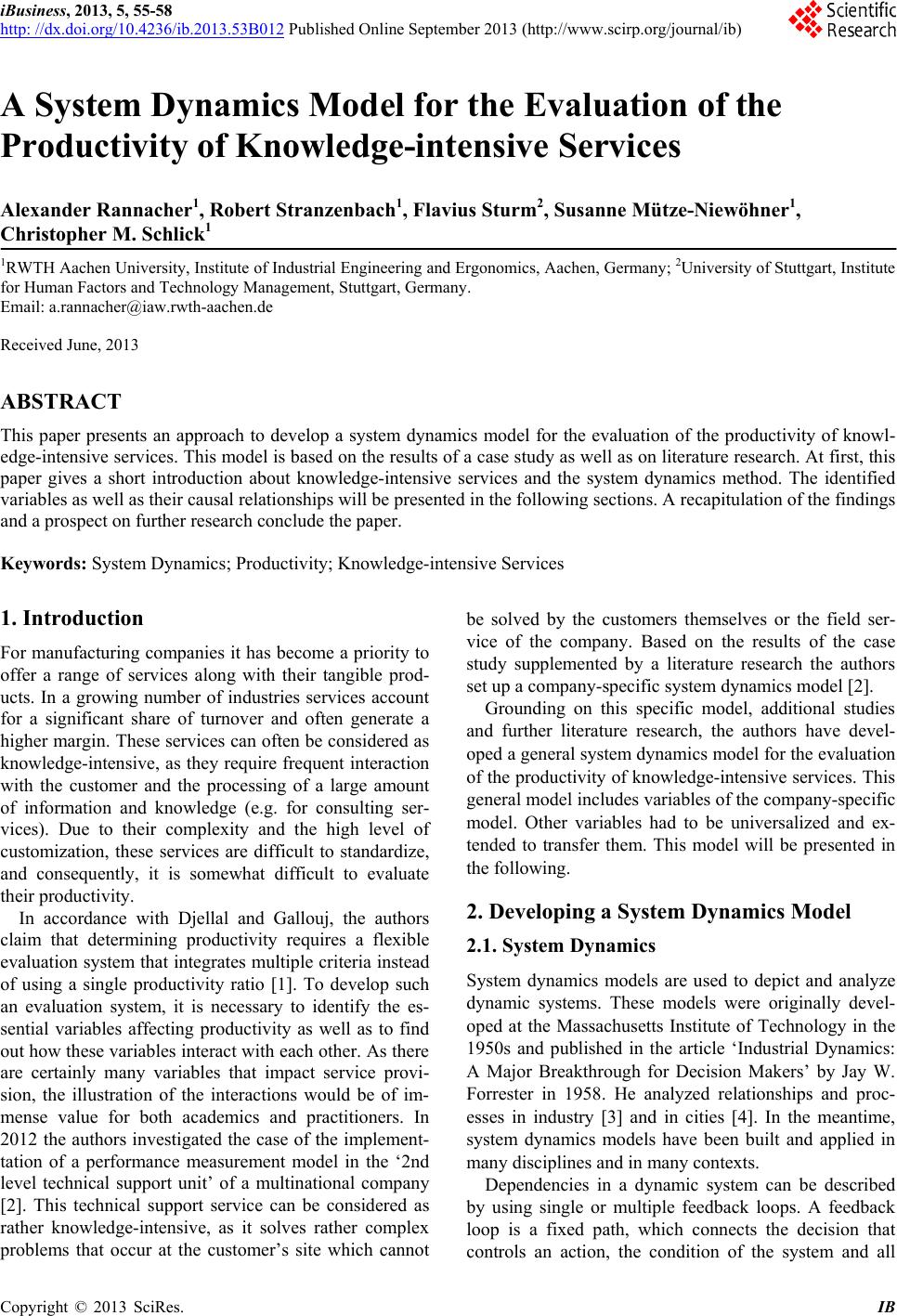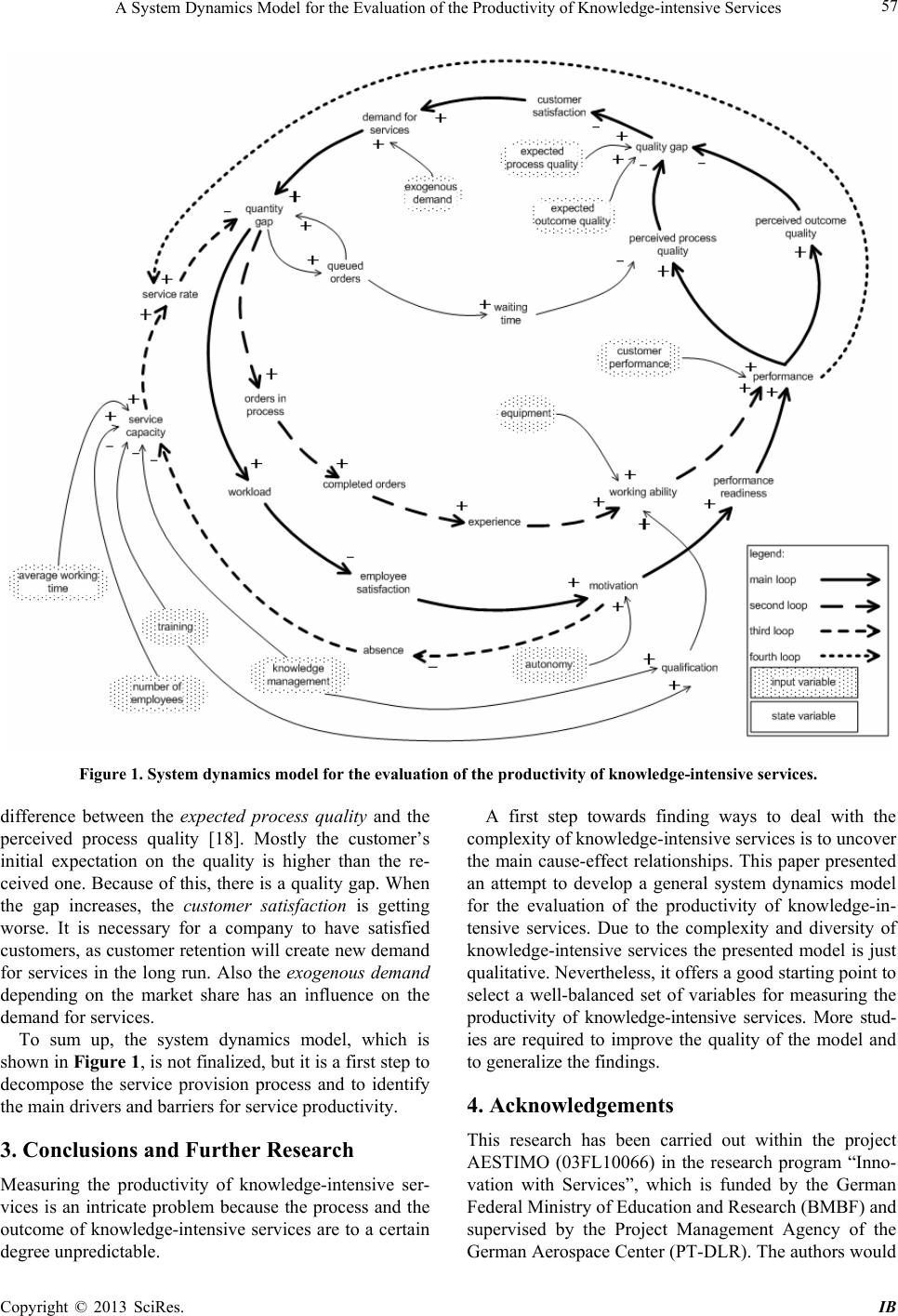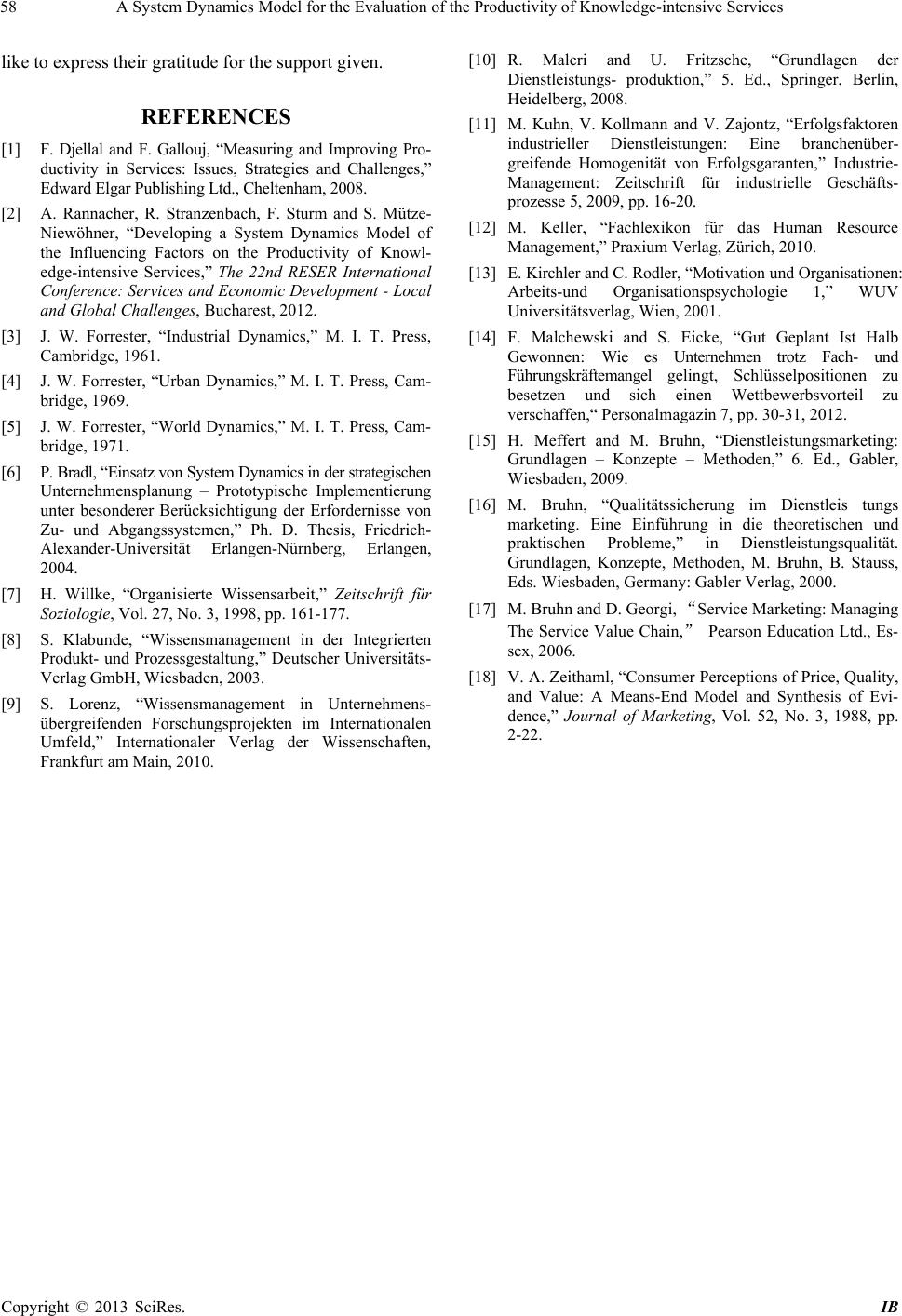Paper Menu >>
Journal Menu >>
 iBusiness, 2013, 5, 55-58 http: //dx.doi.org/10.4236/ib.201 3.53B012 Published Online September 2013 (http://www.scirp.org/journal/ib) 55 A System Dynamics Model for the Evaluation of the Productivity of Knowledge-intensive Services Alexander Rannacher1, Robert Stranzenbach1, Flavius Sturm2, Susanne Mütze-Niewöhner1, Christopher M. Schlick1 1RWTH Aachen University, Institute of Industrial Engineering and Ergonomics, Aachen, Germany; 2University of St uttga rt, Inst itute for Human Factors and Technology Management, Stuttgart, Germany. Email: a.rannacher@iaw.rwth-aachen.de Received June, 2013 ABSTRACT This paper presents an approach to develop a system dynamics model for the evaluation of the productivity of knowl- edge-intensive services. This model is based on the results of a case study as well as on literature research. At first, this paper gives a short introduction about knowledge-intensive services and the system dynamics method. The identified variables as well as their causal relationship s will b e presented in the following sections. A recapitulation of the findings and a prospect on further research conclude the paper. Keywords: System Dynamics; Productivity; Knowledge-intensive Services 1. Introduction For manufacturing companies it ha s become a priority to offer a range of services along with their tangible prod- ucts. In a growing number of industries services account for a significant share of turnover and often generate a higher margin. These services can often be considered as knowledge-intensive, as they require frequent interaction with the customer and the processing of a large amount of information and knowledge (e.g. for consulting ser- vices). Due to their complexity and the high level of customization, these services are difficult to standardize, and consequently, it is somewhat difficult to evaluate their productivity. In accordance with Djellal and Gallouj, the authors claim that determining productivity requires a flexible evaluation system that integ rates multiple criteria instead of using a single productivity ratio [1]. To develop such an evaluation system, it is necessary to identify the es- sential variables affecting productivity as well as to find out how these variables in teract with each other. As there are certainly many variables that impact service provi- sion, the illustration of the interactions would be of im- mense value for both academics and practitioners. In 2012 the authors investigated the case of the implement- tation of a performance measurement model in the ‘2nd level technical support unit’ of a multinational company [2]. This technical support service can be considered as rather knowledge-intensive, as it solves rather complex problems that occur at the customer’s site which cannot be solved by the customers themselves or the field ser- vice of the company. Based on the results of the case study supplemented by a literature research the authors set up a company-specific system dynamics model [2]. Grounding on this specific model, additional studies and further literature research, the authors have devel- oped a general system dynamics model for the evaluation of the productivity of knowledge-intensive services. This general model includes variables of the company-specific model. Other variables had to be universalized and ex- tended to transfer them. This model will be presented in the following. 2. Developing a System Dynamics Model 2.1. System Dynamics System dynamics models are used to depict and analyze dynamic systems. These models were originally devel- oped at the Massachusetts Institute of Technology in the 1950s and published in the article ‘Industrial Dynamics: A Major Breakthrough for Decision Makers’ by Jay W. Forrester in 1958. He analyzed relationships and proc- esses in industry [3] and in cities [4]. In the meantime, system dynamics models have been built and applied in many disciplines and in many contexts. Dependencies in a dynamic system can be described by using single or multiple feedback loops. A feedback loop is a fixed path, which connects the decision that controls an action, the condition of the system and all Copyright © 2013 SciRes. IB  A System Dynamics Model for the Evaluation of the Productivity of Knowledge-intensive Services 56 information regarding to the condition, being reported at the decision point [5]. Therefore, system dynamics mod- els are suitable to identify th e effects of a single action in the course of a process, allowing the detection of delays within processes, caused by a badly designed flow of information. Therefore, a reshaping of the information flows is possible [6]. To depict feedback loops, so-called Causal Loop Dia- grams are used to describe the causal dependencies be- tween system elements, as well as the polarity of the de- pendencies. The polarity of the feedback loop may be either reinforcing (positive polarity) or balancing (nega- tive polarity). Hence nonlinear feedback systems can be generated. The systematic variation of information rela- tionships, interaction loops and dependencies in system dynamics models help to clarify the performance of a system in its entirety. 2.2. Structure of the System Dynamics Model The system dynamics model presented in Figure 1 shows all variables influencing the productivity of knowledge- intensive services. Con nections between variables d epict, which ones are influencing other variables. The spear- head indicates the direction of the influence. In addition, the spearhead shows the kind of influence as a ‘+’ for proportional influence and a ‘–’ for inversely propor- tional influence. The evaluation, whether the influence is proportional or inversely proportional, requires the sim- plified assumption that all other variables stay constant, even though this is actually impossible due to the feed- back. The dotted variables are input variables. These variables are not influenced by any other variables. The blank variables are the so called state variables. All state variab les combin ed are ch aracterizin g the curren t state of the complete system. The presented system dynamics model can be divided into four feedback loops. The nota- tion of these loops is defined in the legend of Figure 1. 2.3. Variables of the System Dynamics Model The service capacity is an existential potential of a ser- vice company to be able to provide their services. In- creasing the two input variables number of employees and average working time causes a positive service ca- pacity. Knowledge management (i.e. the creation, sharing, capturing and distribution of knowledge) is one of the main input variables on the productivity of knowl- edge-intensive services. The most important resource for these services is, of course, knowledge [7]. Providing more knowledge management increases the level of qualification of each employee [8] and effectively re- duces service capacity [9] at the same time. Because knowledge management is not influenced by any other variable, it can be seen as an input variable for the ser- vice provider. The number of trainings is another sig- nificant input variable, which can be influenced by the service provider. On the one hand trainings reduce ser- vice capacity, but on the other hand they increase the qualification of the employees. Knowledge-intensive employees should frequently attend trainings to improve their qualification [10,11]. So only a reasonable level of qualification enables employees to perform their work (working ability) sufficiently. Another input variable which can be influenced by the company is equipment. Equipment is obviously neces- sary to provide any kind of service. If there is no func- tional equipment, the employees need more time to per- form their tasks properly. In addition, using the right equipment increases the working ability of the employees [12]. The autonomy of the employees is another input vari- able. It signifies that employees are allowed to manage their work by themselves (e.g. autonomous sequencing of tasks). A higher degree of autonomy may have a positive effect on their motivation [13]. Motivated employees have a higher performance readiness and a lower ab- sence [14]. Combining the performance readiness with the working abilit y leads to the performance [10,15]. The performance is the ability of a service provider to per- form a service matching the customer’s requirements on a specific level [16]. The performance contains the ability of the service provider as well as the willingness to per- form the service. The customer performance as an input variable describes the p erformance or the activities that a customer is supplying in order to achieve a specified ser- vice outcome. The performance on the one hand combined with the service capacity on the other hand influence the service rate in a proportional way. The service rate is the average number of orders that can be served in a specific time. The difference between service capacity and demand for services is the so called quantity gap. Consequently, the service provider always attempts to keep the qu antity gap small. When there is not enough demand for the given service capacity, a service is not profitable [17]. The bigger the quantity gap is, the more the workload of the employees and the orders in process rise. The work- load has a main influence on the employee satisfaction. Additionally, more orders in process lead to more com- pleted orders, which extend the experience. Queued or- ders are those orders, which cannot be started immedi- ately, because the demand is high er than the service rate. Unfortunately, queued orders increase the waiting time and therefore lower the perceived process quality. In addition to the quantity gap there is also a quality gap. Comparing the expected outcome quality with the perceived outcome quality the customer will normally have a mismatch. Secondary this gap is generated by the Copyright © 2013 SciRes. IB  A System Dynamics Model for the Evaluation of the Productivity of Knowledge-intensive Services Copyright © 2013 SciRes. IB 57 Figure 1. System dynamic s mode l for the evaluation of the produc tivity of know le dge -intensive services. difference between the expected process quality and the perceived process quality [18]. Mostly the customer’s initial expectation on the quality is higher than the re- ceived one. Because of this, there is a quality gap. When the gap increases, the customer satisfaction is getting worse. It is necessary for a company to have satisfied customers, as customer retention will create new demand for services in the long run. Also the exogenous demand depending on the market share has an influence on the demand for services. A first step towards finding ways to deal with the complexity of knowledg e-intensiv e serv ices is to un cov er the main cause-effect relationships. This paper presented an attempt to develop a general system dynamics model for the evaluation of the productivity of knowledge-in- tensive services. Due to the complexity and diversity of knowledge-intensive services the presented model is just qualitative. Nevertheless, it offers a good starting point to select a well-balanced set of variables for measuring the productivity of knowledge-intensive services. More stud- ies are required to improve the quality of the model and to generalize the findings. To sum up, the system dynamics model, which is shown in Figure 1, is not finalized, but it is a first step to decompose the service provision process and to identify the main drivers and barriers fo r service productivity. 4. Acknowledgements This research has been carried out within the project AESTIMO (03FL10066) in the research program “Inno- vation with Services”, which is funded by the German Federal Ministry of Education and Research (BMBF) and supervised by the Project Management Agency of the German Aerospace Center (PT-DLR). The authors would 3. Conclusions and Further Research Measuring the productivity of knowledge-intensive ser- vices is an intricate problem because the process and the outcome of knowledge-intensive services are to a certain degree unpredictable.  A System Dynamics Model for the Evaluation of the Productivity of Knowledge-intensive Services 58 like to express their gratitude for the support given. REFERENCES [1] F. Djellal and F. Gallouj, “Measuring and Improving Pro- ductivity in Services: Issues, Strategies and Challenges,” Edward Elgar Publishing Ltd., Cheltenham, 2008. [2] A. Rannacher, R. Stranzenbach, F. Sturm and S. Mütze- Niewöhner, “Developing a System Dynamics Model of the Influencing Factors on the Productivity of Knowl- edge-intensive Services,” The 22nd RESER International Conference: Services and Economic Development - Local and Global Challenges, Bucharest, 2012. [3] J. W. Forrester, “Industrial Dynamics,” M. I. T. Press, Cambridge, 1961. [4] J. W. Forrester, “Urban Dynamics,” M. I. T. Press, Cam- bridge, 1969. [5] J. W. Forrester, “World Dynamics,” M. I. T. Press, Cam- bridge, 1971. [6] P. Bradl, “Einsatz vo n Sy ste m Dy na mic s in de r strate gische n Unternehmensplanung – Prototypische Implementierung unter besonderer Berücksichtigung der Erfordernisse von Zu- und Abgangssystemen,” Ph. D. Thesis, Friedrich- Alexander-Universität Erlangen-Nürnberg, Erlangen, 2004. [7] H. Willke, “Organisierte Wissensarbeit,” Zeitschrift für Soziologie, Vol. 27, No. 3, 1998, pp. 161-177. [8] S. Klabunde, “Wissensmanagement in der Integrierten Produkt- und Prozessgestaltung,” Deutscher Universitäts- Verlag GmbH, Wiesbaden, 2003. [9] S. Lorenz, “Wissensmanagement in Unternehmens- übergreifenden Forschungsprojekten im Internationalen Umfeld,” Internationaler Verlag der Wissenschaften, Frankfurt am Main, 2010. [10] R. Maleri and U. Fritzsche, “Grundlagen der Dienstleistungs- produktion,” 5. Ed., Springer, Berlin, Heidelberg, 2008. [11] M. Kuhn, V. Kollmann and V. Zajontz, “Erfolgsfaktoren industrieller Dienstleistungen: Eine branchenüber- greifende Homogenität von Erfolgsgaranten,” Industrie- Management: Zeitschrift für industrielle Geschäfts- prozesse 5, 2009, pp. 16-20. [12] M. Keller, “Fachlexikon für das Human Resource Management,” Praxium Verlag, Zürich, 2010. [13] E. Kirchler and C. Rodler, “Motivation und Orga nisationen: Arbeits-und Organisationspsychologie 1,” WUV Universitätsverlag, Wien, 2001. [14] F. Malchewski and S. Eicke, “Gut Geplant Ist Halb Gewonnen: Wie es Unternehmen trotz Fach- und Führungskräftemangel gelingt, Schlüsselpositionen zu besetzen und sich einen Wettbewerbsvorteil zu verschaffen,“ Personalmagazin 7, pp. 30-31, 2012. [15] H. Meffert and M. Bruhn, “Dienstleistungsmarketing: Grundlagen – Konzepte – Methoden,” 6. Ed., Gabler, Wiesbaden, 2009. [16] M. Bruhn, “Qualitätssicherung im Dienstleis tungs marketing. Eine Einführung in die theoretischen und praktischen Probleme,” in Dienstleistungsqualität. Grundlagen, Konzepte, Methoden, M. Bruhn, B. Stauss, Eds. Wiesbaden, Germany: Gabler Verlag, 2000. [17] M. Bruhn and D. Georgi, “Service Marketing: Managing The Service Value Cha in,” Pearson Education Ltd., Es- sex, 2006. [18] V. A. Zeithaml, “Consumer Perceptions of Price, Quality, and Value: A Means-End Model and Synthesis of Evi- dence,” Journal of Marketing, Vol. 52, No. 3, 1988, pp. 2-22. Copyright © 2013 SciRes. IB |

